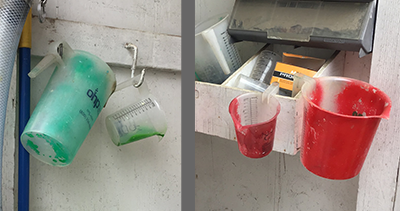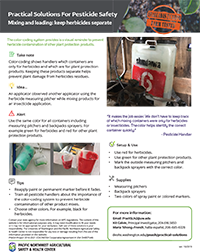
Measuring pitchers sprayed red for use with herbicides. Photos by Kit Galvin.
 Take note
Take note
Color-coding shows handlers which containers are only for herbicides and which are for plant protection products. Keeping these products separate helps prevent plant damage from herbicides residues.
 Idea...
Idea...
An applicator observed another applicator using the herbicide measuring pitcher while mixing products for an insecticide application.
 Alert
Alert
Use the same color for all herbicide containers including measuring pitchers and backpacks sprayers. Use a different color for plant protection product containers.
 Setup & use
Setup & use
- Use red for herbicides.
- Use green for other plant protection products.
- Mark the outside measuring pitchers and backpack sprayers with the correct color.
 Supplies
Supplies
- Measuring pitchers
- Backpack sprayers
- Two colors of spray paint or colored markers


the correct container quickly.”
 Tips
Tips
- Reapply paint or permanent marker before it fades.
- Train all pesticide handlers about the importance of the color-coding system to prevent herbicide contamination of other product mixes.
- Choose other colors. For example, black for herbicides.
We hope that you are inspired to use these solutions in your workplace. Did you try one of the practical solutions or develop a new one? We would appreciate hearing about your ideas and experiences.
Thank you and safe pesticide handling,
PNASH
Contact your state agency for more information on WPS regulations. The content of this website is for informational purposes only. It may need modification to fit your needs or it may not be appropriate for your workplace. Safe use of these solutions is your responsibility. The University of Washington and the Pacific Northwest Agricultural Safety & Health Center is not responsible for any loss or damage resulting from the use of the information provided on this website.
PNASH Project 2016-2021 (CDC/NIOSH Cooperative Agreement # U54 OH007544)
Contact us
Project Email:
PractSLN2@uw.edu
Project staff:
Maria Tchong-French (habla español)
Email: mitchong@uw.edu
206.685.6728

